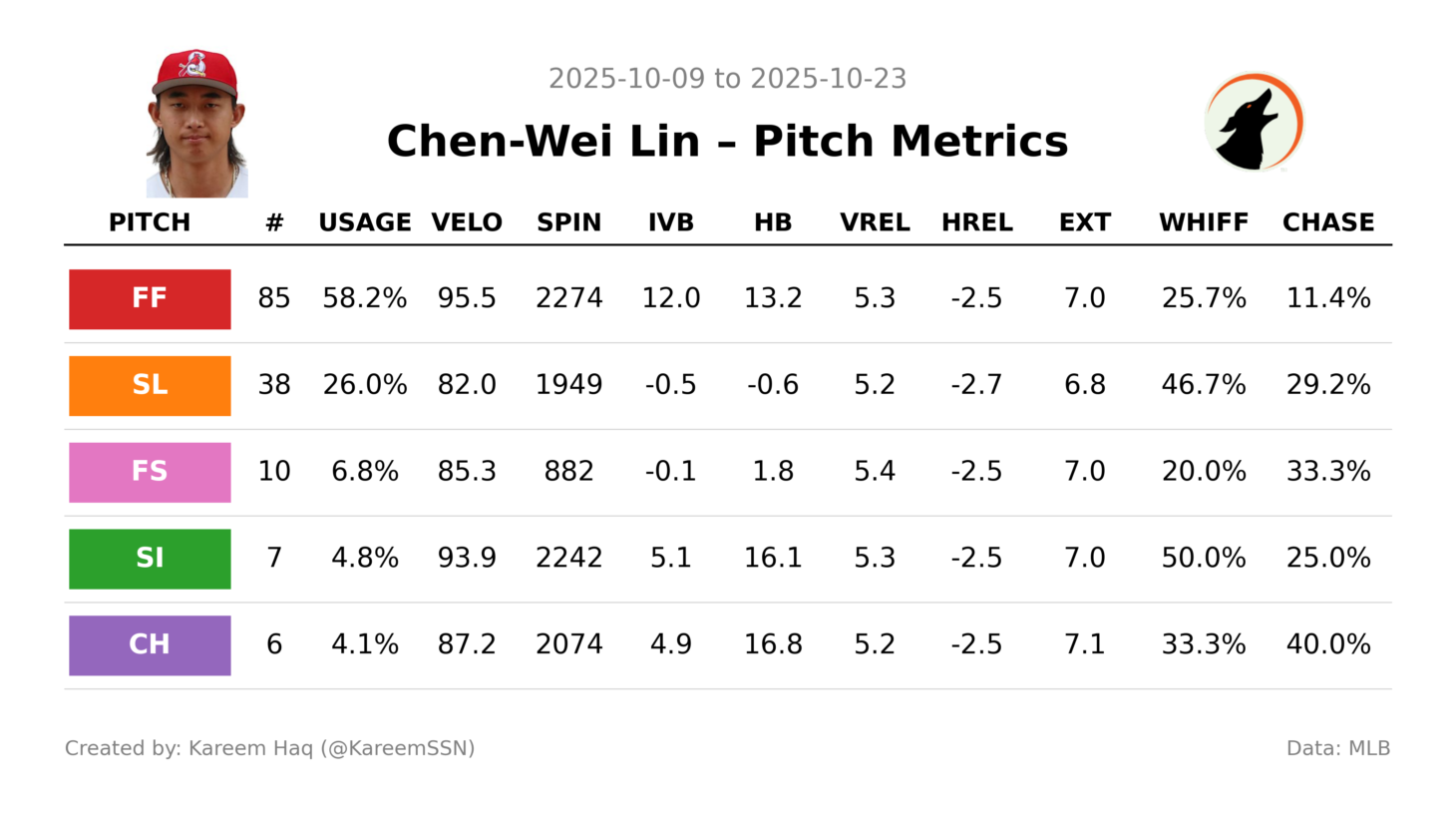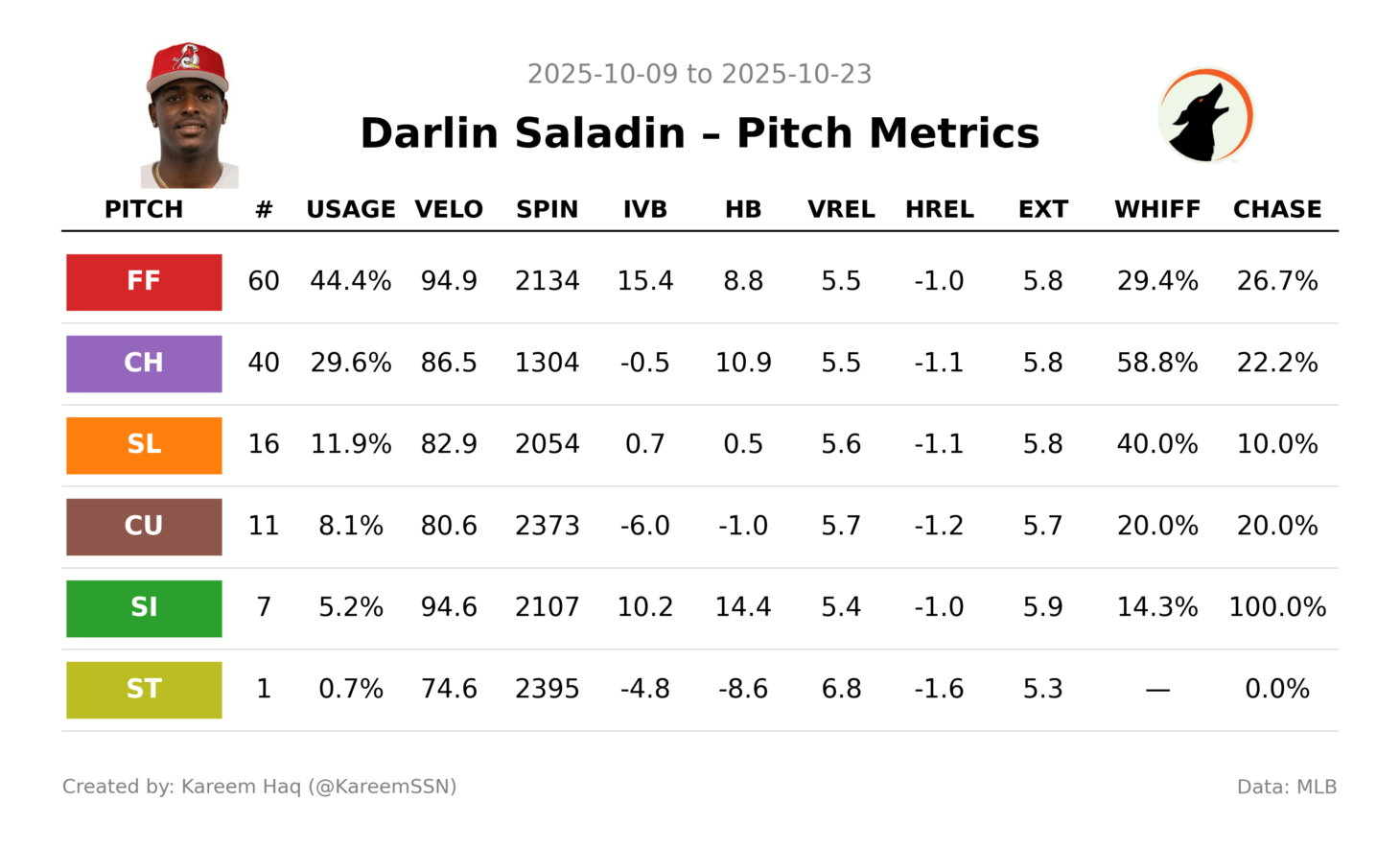Checking In on Cardinals Prospects in the Arizona Fall League
RHP Chen-Wei Lin
Heading into the AFL, Lin was easily the most intriguing prospect the Cardinals sent to the league. I have him slotted at No. 16 in my updated Cardinals prospect rankings. After a breakout 2024 season in which he logged 116 innings at the Single-A level, Lin hit a roadblock in 2025 with a forearm injury that limited him to just 50.1 innings. During that span, he showed sporadic command after flashing promising control the previous year, when he posted a 7.8% walk rate. That number ballooned to a concerning 17.5% in 2025.
Lin was a prime candidate for the Arizona Fall League given the time he missed this year, and a successful showing could put him back on an upward trajectory. The key for him is straightforward — regaining his command and control to a respectable level. Lin has the raw stuff to project as a future big leaguer, but his staying power will ultimately hinge on his ability to consistently throw strikes. If he can regain that command, he has a legitimate chance to become a starter, which would make his profile far more intriguing.
Lin has made three starts so far in the Arizona Fall League, showing flashes of brilliance — though his control has still been inconsistent from outing to outing. His second start was clearly his best, when he logged 3.2 scoreless innings with five strikeouts and no walks, impressively landing 31 of 37 pitches for strikes. However, he hasn’t replicated that same level of success in his other two appearances, combining for five walks over 3.2 innings.
Lin’s release height has dropped by about half a foot compared to his 2024 Florida State League data, and his entire arsenal has subsequently shifted lower in terms of induced vertical break. Notably, his four-seamer is down two inches in IVB, while his slider — now more of a true bullet — has lost 4.8 inches of IVB. The pitch has always tilted arm-side due to Lin’s pronation bias, but it has flashed more glove-side cut lately, particularly in his first AFL start, when all eight of his sliders broke glove-side (though still hovering near zero).
Lin mentioned in an interview that he’s not overly concerned with the pitch’s movement profile and is instead focused on increasing its velocity. The pitch has actually lost some velocity compared to his 2024 season — when I already felt it could use a bit more. Hopefully, we’ll see that number climb closer to the high 80s in the future without sacrificing much vertical movement.
RHP Darlin Saladin
While Chen-Wei Lin was the most exciting prospect heading into the Fall League, Saladin will be the most exciting prospect heading out. In particular, his pitch data looks night-and-day different from his 2024 season in the Florida State League. Before digging into that, I’d like to touch on Saladin’s 2025 regular season.
Saladin broke out in a major way in 2024, much like Lin, delivering 123 innings with a 2.71 ERA between Palm Beach (A) and Peoria (A+). He was assigned back to High-A to start his 2025 season, and he got off to a rough start — posting a 5.43 ERA over his first 63 innings. However, he ended the season on a strong note with a 3.69 ERA over his final 31.2 innings, though his overall numbers were still a far cry from his dominant 2024 campaign.
Saladin’s early-season struggles weren’t tied to one specific issue, but rather a culmination of many different factors. His velocity was inconsistent, his command took a step back, and he didn’t have a reliable secondary pitch to keep hitters off his heater. While some of the velocity fluctuation remained, he showed more confidence in his secondary mix — especially a new changeup with added vertical depth that's emerging as a legitimate swing-and-miss weapon.
Saladin also debuted a curveball during the 2025 season, giving him another weapon to pair with his reworked changeup. Building on that progress with his secondaries will be key for his time in the AFL.
Saladin has easily been the Cardinals’ standout performer in the AFL, tossing seven scoreless innings with ten strikeouts. Seven of those punchouts have come on his reworked changeup, and oh boy, the pitch metrics are exciting.
Darlin Saladin’s changeup metrics:
2024 (FSL): 86.0 MPH, 1692 RPM, 11.1” IVB, 13.0” HB
2025 (AFL): 86.5 MPH, 1304 RPM, -0.5” IVB, 10.9” HB
Saladin’s changeup has transformed from a pitch with more of a runner shape — one that wasn’t suited for generating consistent swing-and-miss results — into a dominant offering with elite depth, now averaging negative induced vertical break. The vertical separation between his fastball and changeup has jumped from 5 inches in 2024 to 15 inches this year. The swing-and-miss numbers in the Fall League have been outstanding, as he’s producing a 58.8% whiff rate on the pitch while throwing it 29.6% of the time and showing confidence to use it against hitters from both sides.
Saladin’s curveball is a “deathball” shape, sitting at 80.6 MPH with -6 inches of induced vertical break and nearly zero horizontal movement. More importantly, it adds another distinct pitch shape to his arsenal. He’s transformed himself from a pronation-heavy pitcher with a limited mix into one with a well-rounded repertoire — one that should play nicely in a starting role.
To illustrate this, here’s a look at his pitch plot from the 2024 season in the Florida State League (left) compared to his pitch plot so far in the Arizona Fall League (right).
Saladin’s fastball velocity has climbed to an average of 94.9 MPH, up two ticks from his 2024 season in the FSL. Despite pitching in shorter stints, he’s showing more explosiveness than ever and has reached a Statcast-tracked career high of 96.6 MPH.
While I’m not ready to move Saladin back into my top 30 Cardinals prospects rankings, I’m highly encouraged by what he’s shown in the Fall League. The development of a true wipeout secondary in his changeup is exciting, and the velocity uptick he’s shown gives me confidence that his stuff could potentially play well out of a big-league bullpen.
OF Travis Honeyman
After being limited to just 20 games over his first two seasons in pro ball due to a shoulder injury, Honeyman finally stayed on the field consistently in 2025, appearing in 82 games between Palm Beach (A) and Peoria (A+). He got off to a torrid start in the Florida State League, finishing with an .889 OPS before earning a promotion to Peoria. Though he wasn’t able to replicate that same level of success, he continued to display impressive bat-to-ball skills and a disciplined approach at the plate, walking 13.1% of the time across both levels.
While Honeyman showed strong on-base ability, his in-game power was limited. His exit velocities in the Florida State League were modest, with an average of 87 MPH, a 90th-percentile mark of 101.5 MPH, and a 33.3% Hard-Hit rate. He managed to hit only three home runs in 358 plate appearances between Single-A and High-A, producing a .080 ISO. For a player who showed significantly more power potential during his college days at Boston College, those numbers were quite underwhelming.
Heading into the AFL, the two key things I’m watching are his defense in center — especially important if the power doesn’t come around — and the aforementioned power itself, where I’d like to see progress. I’ve mentioned before that I’d like to see Honeyman go through some sort of bat speed program, and I still think it would benefit him greatly. He’s a twitchy athlete with more bat speed left to unlock, and tapping into that could help him better access his power in games.
Honeyman kicked off his AFL tenure with a bang, launching a 106.9 MPH moonshot home run in his second game as part of a two-hit performance. Not too shabby for a hitter who hasn’t shown much power so far in his professional career — and it only reinforces my belief that there’s more in the tank.
It’s been quiet since then, as he’s gone hitless in his last three games before being sidelined with a knee injury, which fortunately isn’t deemed to be serious.
RHP DJ Carpenter
Lastly, DJ Carpenter isn’t someone I expected to be writing about, but you can add him to the laundry list of relief pitching prospects in the organization with intriguing stuff. Before the AFL, we didn’t have any public Statcast data on Carpenter, but he was known for a fastball sitting in the mid-90s paired with a solid breaking ball.
The Cardinals drafted Carpenter in the 14th round out of Oregon State — the same year his OSU teammate, Cooper Hjerpe, was selected in the first round. Carpenter missed both the 2023 and 2024 seasons recovering from Tommy John surgery but returned this year to throw 37 innings for High-A Peoria, posting a 5.35 ERA. He struck out 23% of batters faced, but his 16.9% walk rate wasn’t sufficient enough to find success at that level.
Carpenter’s focus in the AFL is straightforward: throw more strikes. The stuff is there, but it won’t play if he continues to hand out free passes at that rate. That said, giving him additional innings in the Arizona Fall League after nearly three years away from competition is a smart move. So far, he’s logged 2.2 innings with two walks, and while the sample is small, the raw stuff stands out.
Carpenter’s fastball is averaging 96.3 MPH and topping out at 98.5 MPH, featuring a cut-ride shape from a steep 6.6-foot vertical release. He pairs the heater with an 86 MPH sweeper that has about 10 inches of glove-side movement and he spins it well. He’s solely throwing those two pitches and using them close to a 50-50 split. He hasn’t induced much swing-and-miss in a small sample, but the stuff still intrigues me.
While Carpenter isn’t someone I’d rank inside the organization’s top 50 until he proves it with more consistent results, he’s far more interesting than just an organizational depth arm.






